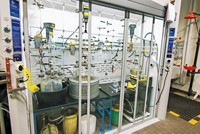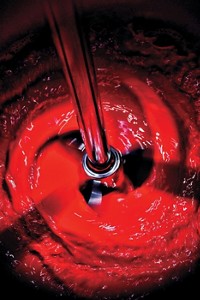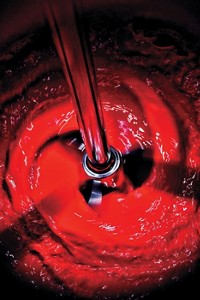Advertisement
Grab your lab coat. Let's get started
Welcome!
Welcome!
Create an account below to get 6 C&EN articles per month, receive newsletters and more - all free.
It seems this is your first time logging in online. Please enter the following information to continue.
As an ACS member you automatically get access to this site. All we need is few more details to create your reading experience.
Not you? Sign in with a different account.
Not you? Sign in with a different account.
ERROR 1
ERROR 1
ERROR 2
ERROR 2
ERROR 2
ERROR 2
ERROR 2
Password and Confirm password must match.
If you have an ACS member number, please enter it here so we can link this account to your membership. (optional)
ERROR 2
ACS values your privacy. By submitting your information, you are gaining access to C&EN and subscribing to our weekly newsletter. We use the information you provide to make your reading experience better, and we will never sell your data to third party members.
Materials
Fixing A Hole
Hole-injection materials are becoming the focus of R&D in next-generation displays
by Alexander H. Tullo
September 11, 2006
| A version of this story appeared in
Volume 84, Issue 37
Commercial success has eluded polymer-based organic light-emitting diodes (OLEDs). Yet the key to any future market breakthrough may not be the light-emitting polymers at the core of these devices but rather the hole-injection layers that play a secondary role.
Compared with small-molecule OLEDs, which are based on molecules such as perylenes and quinacridones, polymer-based OLEDs such as polyfluorenes have shorter lifetimes and lower efficiencies. About 95% of the OLED displays on the market use small-molecule technology, according to display consultancy iSuppli.
But experts say small-molecule OLEDs will be uneconomical for use in larger displays, such as computer screens and televisions, because they are applied by expensive vapor deposition technology. For such applications, polymer-based OLEDs would be economical because they are applied in solution processes resembling printing. However, the performance of polymer-based OLEDS, or PLEDs, first needs to improve before that production advantage can be of use.
To increase the lifetime and efficiency of these materials, the PLED industry is focusing much of its attention on the hole-injection layer. "The common belief within the field is that one of the barriers to long lifetime is the hole-injection layer," says Shawn P. Williams, vice president of technology for Pittsburgh-based Plextronics.
The hole-injection layer supplies positively charged "holes" to the emissive polymer for combination with electrons to give off photons. Williams explains that a well-functioning hole-injection layer supplies enough holes to the surface of the light-emitting polymer that the desired combination of holes and electrons will occur in the polymer and nowhere else.
Experts agree that the benchmark hole-injection layer for PLEDs has been poly-(3,4-ethylenedioxythiophene)/polystyrenesulfonate, or PEDOT:PSS, from Bayer's H.C. Starck unit. The material was originally developed as a waterborne, antistatic coating for photographic films. According to John Bayley, a product manager at Starck, PEDOT:PSS was first eyed as a material for the hole-injection layer in 1993 and has since replaced the polyanilines that were originally employed. "Now, all important customers use this material for PLED devices," he says.
Competitors claim, however, that PEDOT:PSS has its limitations and can carry the PLED industry only so far. Companies such as Plextronics and Air Products & Chemicals are working on next-generation materials that they say will help enable PLED commercialization.
Williams says PEDOT:PSS doesn't have the flexibility to work optimally with varying light-emitting polymer chemistries. "The idea of coming out there and having a one-size-fits-all hole-injection material is probably a little bit simplistic," he says.
For his part, Bayley points to the success that Starck has had so far in hole-injection layers. He adds that the company supplies custom grades of PEDOT:PSS on tight specifications.
Plextronics is targeting the hole-injection layer with its Plexcore platform, largely based on regioregular polythiophene conductive polymer chemistry that was developed by company founder Richard D. McCullough, a chemistry professor at Carnegie Mellon University. But, Williams stresses, Plexcore is meant to be a flexible platform that can be tuned to particular light-emitting polymers by changing the conductive polymer and the dopants used in the formulation.
In some cases, Williams says, the use of Plexcore has led to emitter lifetimes of up to four times longer than those obtained with PEDOT:PSS. "I can't say we have solved all the problems, but we have had very good performance in some systems," he says.
Plextronics is working on full-scale manufacturing trials with a display manufacturer in Asia and hopes to have materials commercially qualified by next year.
In July, Plextronics added another chemistry to its stable when it signed a licensing agreement with Northwestern University for materials developed by Tobin J. Marks, a professor of catalytic chemistry and materials science. The aromatic amine-based compounds are similar to those used as hole-transport materials in small-molecule, vapor-deposited OLEDs. The difference, Williams explains, is that Marks's materials are cross-linked, which allows them to be used in solution-based manufacturing processes.
Air Products is also licensing hole-injection layer materials from academia. Last month, the company signed an agreement with the University of Connecticut to license polythienothiophene materials invented by chemistry professor Gregory A. Sotzing.
John B. Dickenson, senior business development manager for conductive polymers at Air Products, says his company became interested in hole-injection layers about three years ago as an outgrowth of its large electronic chemicals business. "Some of our scientists were brainstorming ways to look for growth opportunities within that field, and they hit upon this idea of organic electronics," he says.
Dickenson says the field of emitting materials was crowded with companies with vast intellectual property claims, but Air Products saw an opportunity in hole-injection layers. "We found that customers are looking for a better solution than the materials that are available today," he says.
According to Dickenson, one advantage of polythienothiophene materials over PEDOT:PSS is that they don't require a protective interlayer between the hole-injection layer and the emissive polymer. "We will be able to extend the performance envelope as well as simplify things for our customers," he says. In addition, he says, tests have shown that the polythienothiophene materials last 10 times longer than "standard materials."
But the newest generation materials will have a long way to go if they are to displace PEDOT:PSS and advance the PLED industry.






Join the conversation
Contact the reporter
Submit a Letter to the Editor for publication
Engage with us on Twitter